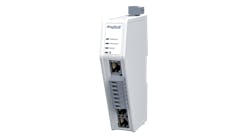The digital transformation of a business can drive up productivity and process efficiency by reshaping how key areas of an organization communicate and interact with one another. By leveraging the power of information to optimize machine operations and decision making, companies can adopt manufacturing strategies underpinned by smart applications and continuous improvement.
Time-sensitive networking (TSN) can be used to enable these strategies and enhance productivity by increasing connectivity and sharing data/information more efficiently between the networks, systems, software layers and machines at the heart of an operation.
Also read: Step up the technology in machine control
For years, automated systems used by manufacturers around the world have been performing their functions according to their original setup, which is often far short of the maximum performance available from the individual machines and subsystems. They run at the speed dictated by the slowest part of the system, delivering an expected, pre-set level of performance, reliability and quality with little apparent scope or opportunity for improvement. Getting all those component parts on the same page from a time and speed point of view can however release their latent potential.
Enter TSN
Information has the power to change everything. In particular, the global trends of Industry 4.0, e-F@ctory and smart manufacturing can help businesses create and utilize smarter machines. They can do so by leveraging digital technologies, such as the Industrial Internet of Things (IIoT), cloud and edge computing and artificial intelligence (AI). These can generate, share and analyze different types of machine data to provide actionable insights in real time. We just need to connect them effectively.
Thanks to continuous monitoring, it is also possible to make accurate digital-twin models and forecasts, supporting and driving continuous improvement of processes and machines, as well as preventing obsolescence. Users can benefit from futureproofed machines that monitor and adapt their performance to offer improved reliability, as well as increased product quality (Figure 1).
Even more, businesses that implement digital-transformation technologies will have the ability to fine-tune operations and parameters based on process knowledge to maximize key performance indicators (KPIs) and output.
At the same time, early anomaly detection can enable more effective maintenance strategies to be implemented. These are based on equipment data and accurate predictive models, enabling manufacturers to extend the service life of their equipment, minimize downtime and improve productivity.
Laying the groundwork in new systems
When it comes to developing the smart, automated systems needed to support customers on their digital journeys, engineers should pay attention to several key aspects. More precisely, they should be equipping a machine with suitable sensors and including new data-capture capabilities that can deliver a competitive advantage, as well as providing external access to all machine variables.
By incorporating smart controllers and sensors, machine builders can help users benefit from greater access to machine data, providing a more comprehensive overview of their operations, supporting data analytics and improving manufacturing processes. Understanding the root cause of a limiting factor can help set up suitable mitigation strategies.
A further step consists of incorporating additional tools, such as machine vision systems and specialized analyzers, to support advanced equipment capabilities. These may include data gathering and analytics for predictive maintenance, quick troubleshooting, remote monitoring and control. Ultimately, the possibilities are endless within the framework of Industry 4.0.
Addressing the limitations of traditional solutions
To fully benefit from these data-driven opportunities, it is essential for machine builders to provide visibility of all machine variables. This is particularly challenging to implement with traditional industrial network technologies, primarily because communications within a machine fall into various categories, and thus have differing requirements. For example, some information must be transferred with deterministic performance—for example, to support processes that require accurate motion control or high reliability for safety purposes.
Other applications are less demanding, and data are shared for informational purposes. Typically, solutions have relied on separate networks, one for control activities and another for supervisory tasks, with a possible bridge to an external IT network.
In addition, while adding more sensors to a setup could be achieved in traditional systems, the data produced by them may not necessarily be accessible from any other device but the machine itself or, more precisely, its controller. Even more, this may not be able to interface with atypical instruments, such as cameras, making it impossible to gather more information on the process or the unit itself.
Besides, the devices on a control network are becoming more sophisticated and require configuration and management, which should be taken into account. A smart camera, for example, is configured for image recognition and resulting actions and then performing that function as part of the control system. Similarly, a modern motion controller offers hundreds of parameters for control and tuning.
Finally, traditional network technologies and sensors typically rely on vendor-specific standards. As a result, businesses can only utilize a limited portfolio of suitable devices that can be incorporated within a system while ensuring effective data transfer.
Leveraging a future-oriented network technology
Ideally, there should be a common backbone for all machine communications that also supports interoperability. In effect, a solution with these characteristics can support the creation of an in-depth process understanding that is generated by merging different types of information. In particular, the convergence of information technology (IT) and operational technology (OT) can help provide the comprehensive, multidisciplinary overview at the core of IIoT frameworks.
The latest TSN technology can be a key ally for machine builders, system integrators and control engineers. This is defined by IEEE 802.1 standards to advance the specifications of standard Ethernet and establish precisely these data-merging functions using accurate synchronization and traffic scheduling. As a result, it is possible to transfer large volumes of data while delivering determinism for urgent messages.
Even more, as any kind of traffic is supported, this technology addresses interoperability by providing a vendor-neutral, open environment. Consequently, it is possible to adopt the sensors and analyzers that are most appropriate to address the specific requirements of a given application.
TSN can also be applied to create a number of topologies, as well as mix different ones within an enterprise, adapting to an intended setup. This innovative network technology is well-suited for star configurations, in place of linear ones. According to these now-accessible topologies, a switch manages all the traffic and devices on the network, being connected to all PLCs, drives and I/O modules, as well as any node that is not capable or aware of real-time communications.
In addition to helping businesses improve troubleshooting by supporting the use of key high-performance automation hardware, the technology can do more. It is compatible with the vast range of standard Ethernet troubleshooting tools used to visualize and analyze a network and communications, as well as interacting with all the devices present.
Finally, TSN enables designers to run both management software and control communications at the same time and on the same wire, supporting next-level configuration and management.
Tom Burke is global strategic advisor at CC-Link Partner Association (CLPA). Contact him at [email protected].





